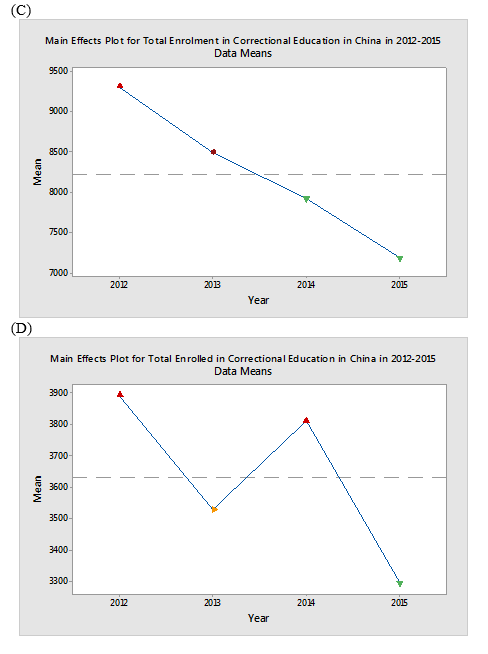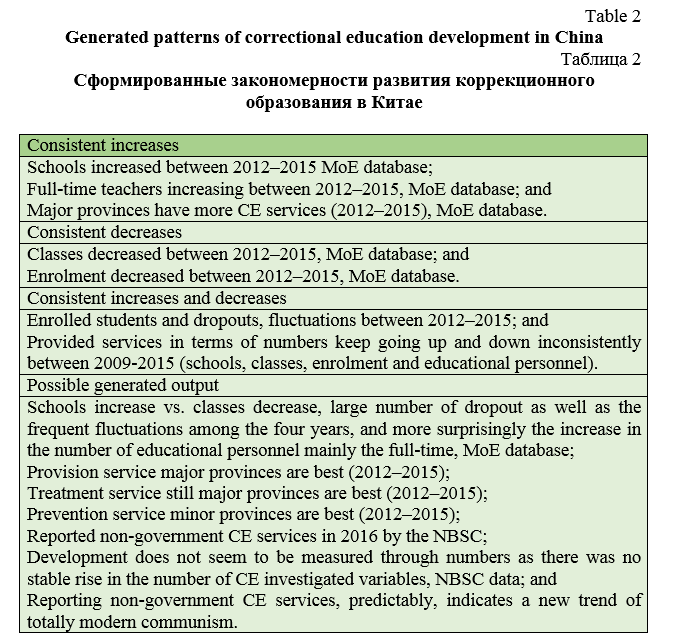Correctional education development in China: an exploratory analysis of quantitative data between 2009 and 2016
Abstract
Purpose: We examined the development of correctional education (CE) in China with reference to the National Plan (2010-2020). Design: A quantitative synthesis was conducted based on a 7-year interval retrieved data (2009/2010-2015/2016) from the Ministry of Education (MoE) and National-Bureau of Statistics of China (NBSC) databases using seven indicators (schools, classes, enrolment, enrolled students, dropouts, educational personnel and full-time teachers) yet representing 31 provinces in China. Findings: The results indicated four patterns of CE development: consistent increase in CE services for some indicators (e.g. schools) – possibly implying successful provision methods; a consistent decrease in some others (e.g. classes) – probably implying impacting prevention methods; and consistent increases and decreases for a few of them (e.g. enrolment) – presumably implying effective vs. ineffective treatment methods.



Results. Table 1 presents the total number of CE schools, classes, enrolment and staff across 2009-2015 in China. It was proposed that the highest numbers in all variables will be for 2015 and lowest will be for 2009. While the data shows 76 as the lowest number of schools, the data indicates that this number is for 2010 which is not the starting comparison point across seven years. On the other hand, it reports 89 as the highest number of schools and the data also indicates the same number for the ending comparison point (i.e. 2015). Interestingly, the lowest number of the classes which is reported as 331 in the table matches with the ending point of comparison, 2015 as compared to the largest number of classes 445-matching the first point of comparison, 2009. This also applies to enrolment where the numbers are reversed to the largest number of enrolment in 2009 and the smallest number in 2015. All in all, this indicates inconsistent development of CE services as per indicated by ups and downs of numbers in the above examined variables.

Besides, the 2016 data from the NBSC database also showed inconsistent numbers when being compared to the period 2009-2015. In other words, the highest numbers in 2016 and the lowest in 2009 were shown only on schools (Range: 72-89) and full-time teachers (Range: 1745-2081) – compared to others which revealed decreases for 2016 as in the highest number for educational personnel is for (2015=3,017) compared to (2016=2,889). Similarly, the graduates, entrants and enrolment all decreased in 2016 (3,298; 3,295; 7,181) respectively as compared to (4,141; 3,811; 7,920) in 2015. Interestingly, the date also reported non-government CE services in 2016 (schools=3), (educational personnel=85), (full-time teachers=68), (graduates=42), (entrants=47) and (enrolment=48)—without any provided data for the previous years unless this is an emerging phenomenon in China. Thus, this could possibly indicate efficient and effective prevention methods leading to decrease the need for provision of correctional education. This could be social justice factors, crime decrease or better employment chances.
Figure 4 shows the type of relationship between schools and classes over 7 years. As is shown, the red line representing the classes keeps moving down while the blue line keeps moving up, albeit, this movement is relative. Given this, the type of pattern which can be recorded is opposite movement. The number of the classes decreases when the number of the schools increases and vice versa.

Fig. 5 shows the type of relationship for enrolment and then enrolled students and dropouts over 7 years. As is seen, while the movement between enrolment and the other two variables is opposite (increase in enrolment leading to decrease in enrolled students and dropouts), the movement between enrolled students and dropouts is parallel (i.e. they both go up and down within the same level). Therefore, the parallel movement between the enrolled students and dropouts leads to a prediction about a shortcoming issue of CE services leading to have relative numbers of enrolled and dropouts.

Fig. 6 presents the comparison for female enrolment in CE over 7 years. As is shown, the type of movement between enrolment and the enrolled and dropout student seems to be converging where the blue line starts too far from the red and green line but they are about to reach one another at the ending point. On the other hand, when comparing the enrolled students and the dropouts, there is no observed consistent pattern although it looks like an opposite movement in some of the patterns.

Fig. 7 displays a comparison of CE staff (i.e. educational personnel and full-time) and female CE staff (i.e. educational personnel and full-time) at a 7-year interval. It seems that the recoded type of movement is more parallel where the movements go within the same direction among all the patterns, albeit, this consistency is relative.

Graphical analysis was run – generating main effects plots – comparing the differences among the means of correctional education schools, classes, enrolment, enrolled students, dropouts, educational personnel and full-time educational personnel – looking for indicators of differences across 2012-2015 (Figure 8A-G). As is shown, variable differences among the means of correctional education were recorded. First, there is difference among the total number of correctional education schools and classes across 2012-2015. However, it was noted that while the number of the schools increased, the number of the classes was decreasing. Second, enrolment generally kept decreasing to reach its big fall in 2015. Therefore, when comparing the total number of enrolled students to dropouts, there were fluctuations in both. Third, the number of educational personnel kept going up and felt down moderately in 2015 as compared to the full-time staff which kept going up until 2015. Although there are recorded differences across the four years, but there are some contradictions (e.g. schools increase vs. classes decrease, large number of dropout as well as the frequent fluctuations among the four years, and more surprisingly the increase in the number of educational personnel mainly the full-time).




Boxplots were generated to show the main differences of seven correctional educational variables across 2012-2015 in thirty-one Chinese provinces (Figure 9A–G). These seven variables are: correctional educational schools, classes, enrolment, enrolled students, dropouts, educational personnel and full-time educational personnel. As is shown, there are types of boxplots in each boxplot: red, blue and empty boxplots. In other words, the red boxplots represent the province with the highest number of correctional education schools, classes, enrolment, enrolled students, dropouts, educational personnel and full-time educational personnel. In comparison, the blue boxplots display the average provinces which are neither zero (as in the case of empty boxplots) nor high as in the case of red boxplots. In summary, the initial indications of these boxplots show either consistent increase or decrease in the distribution of correctional education services. Put differently, if we look at Shanghai province boxplots, so they will be high in the seven variables. Besides, we will see in the discussion if the distribution is really even when compared to the population in each of the 31 provinces.




Hsu method was run to determine if the differences among each variable for the thirty-one provinces are due to provision and treatment or other factors. The Hsu was method was run twice first with the function the smallest mean is the best and then with the function the largest mean is the best (Figure 10A-G). Theoretically, if the means are small it means the level of correctional education is small due to effective provision and treatment methods and if the means are high it means the opposite. As is shown, all means are considered significant when highest is considered the best. On the other hand, the number of significant means goes significantly down when the smallest mean is considered as the best. Considering the fact that this change could be attributed to population differences in each province, so the assumption of provision seems to be weak with this secondary data.







Discussion. Apparently, the results of this study were partially contradicting our proposed assumptions. Put differently, two of the three null hypotheses were accepted – leading to reject the first and the second alternative hypotheses assuming that there will be statistically significant differences in the examined CE indicators at a 7-year interval. On the other hand, the third null hypothesis was rejected – resulting to accept the alternative hypothesis based on geographical typology that there is a significant difference among the 31 Chinese provinces in terms of the examined seven CE indicators. The output is summarised in the table below:


















Reference lists